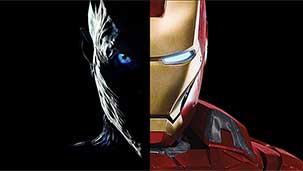Dear Film and TV Lovers,
We are indeed in the endgame, now. But not just for Iron Man and company. The weekend of April 26-28, 2019, will go down in history as the death of film and television as separate mediums—even as both seemingly reach record-breaking heights.
As Thanos might say, it was inevitable. But it’s also exciting—the birth of something new.
In theatres, Avengers: Endgame is smashing box-office records and providing an uncommonly satisfying finale to a decade-long saga. Meanwhile, on TV, the much-hyped Game of Thrones episode “The Long Night” – featuring an 80-minute (feature-film length) Battle of Winterfell – is, similarly, the culmination of years of storytelling in one epic can’t-miss event. Both forced viewers to say goodbye to much loved characters. If you weren’t paying attention, you would think the weekend was a high-water mark for their respective mediums. But if that’s your perspective, well—you know nothing, Jon Snow.
Much like the Avengers themselves grappling with failure, Hollywood should have woken up on Monday and realized that the Marvel Cinematic Universe is not the savior of cinema, and Game of Thrones is not the one true king of television. Instead, their unlikely team-up has created a split in the timeline of what it fundamentally means to be a “film” or “television series”. And there’s no going back.
Think I’m being hyperbolic? Ask Steven Spielberg. Just last month, the most iconic film director of all time was leading a not-so-quiet crusade to push Netflix-produced movies like Roma into Emmy-only awards contention. Quality notwithstanding, the argument went that they should be judged as “TV movies”, based on the primary medium for which they were created. Then, last week, he skipped the Academy of Motion Picture Arts and Sciences’ Board of Governors meeting, having most likely realized that the fight to differentiate the screens upon which we watch has become futile.
You can begin to understand this by examining Endgame’s (highly-effective) advertising campaign. It revels in the past more than it showcases the present (ie. It shows more footage from the other 21 MCU films than from Endgame itself), which is typical for a television series finale but far too niche and alienating for a theatrical experience. At least it used to be. It’s one thing to tune in to see if Dawson ends up back at the creek for the finale (or whatever), but quite another to shell out 20 dollars and risk feeling lost for two hours (or three-plus, in Endgame’s case) . And make no mistake, anyone walking into Endgame cold will feel lost. Because it’s not a film, as we’ve come to know them. It looks like a movie, but it feels like TV—really good TV, to be sure. But it’s three hours of storytelling that is completely connected to, and dependent on, what came before.
So how is that different than your typical Star Wars or Lord of the Rings trilogy, you might ask? Or another tent-pole franchise like Harry Potter? Aside from the marketing, the difference between those other blockbuster franchises and this new species is scale and balance between big and small screens. In other words, television (and streaming) has finally caught up and met films halfway.
There was a time when time itself was the big advantage television had over films. More time to dig into characters, more time to grow emotional attachments, more time to explore story opportunities. But when you weigh the 48 total hours of MCU films vs. the 68 total hours of Game of Thrones (up until Season 8, Episode 3), you can see how the two biggest stories in both “mediums” have rendered that difference all but moot.
Films, on the other hand, could usually boast much larger budgets than TV, and tantalize viewers with productions value that just wasn’t feasible on the small screen. Again, with Game of Thrones’ $90M budget for the final season (and, clearly, very little of that going into the first two episodes), HBO is smartly focusing their money on staging a battle that did not look like anything that had ever appeared on television before. Even production processes are streamlining. Whereas television producers usually cram in as much shooting as possible within tight schedules to meet the demanding output requirements, the Battle of Winterfell alone took 55 days to shoot (longer than most feature films). This HBO strategy isn’t a kamikaze one-off, but the new high standard. The billion dollar investment in the Lord of the Rings franchise by Amazon made sure of that. And with Disney+ and Apple TV+ soon coming to market, the maps will once again have to be completely redrawn.
So what’s left to differentiate one art form from the other? Primary exhibition, I suppose. Which doesn’t really change anything, other than perceived value. If Picasso put a painting on his fridge instead of a gallery, would it would be worth less? Would it be considered a minor work? The process and tools to make it are the same, the final artistic result is the same, the only difference is where it’s seen. And nowadays, most people would prefer to see art home, anyway. HBO has been telling us for years that they aren’t TV—and they may have finally proven it.
But, in the end, it may not really matter who wins the debate. When it comes to fighting over film vs TV definitions of long-form storytelling, it’s the audience who wins big.
Sincerely,

Christopher







